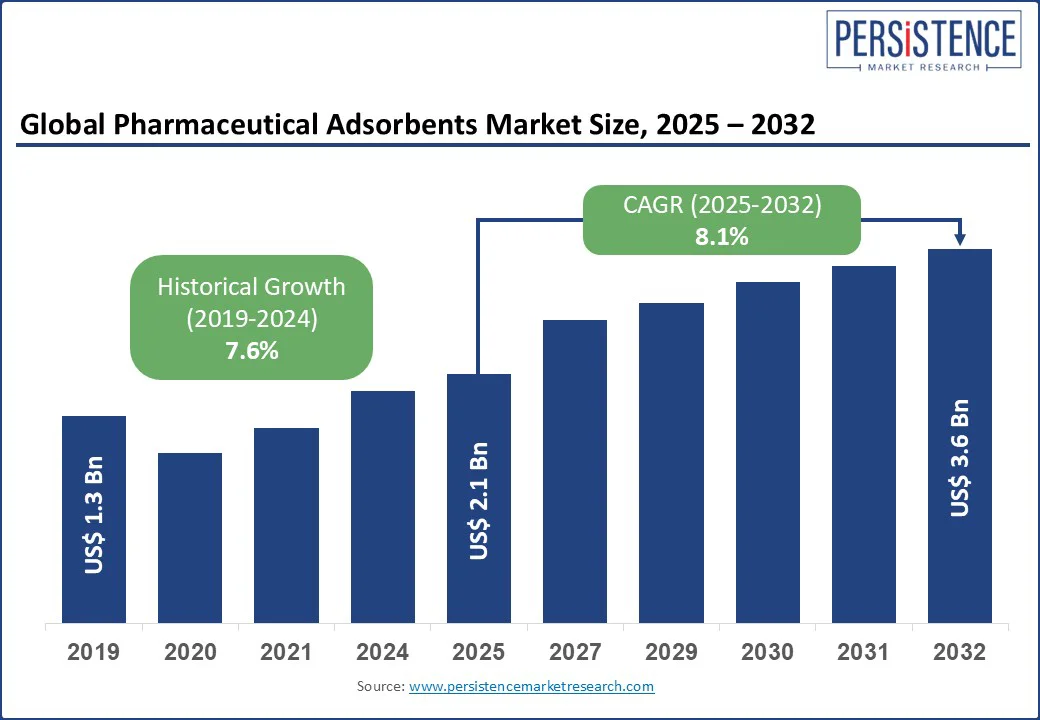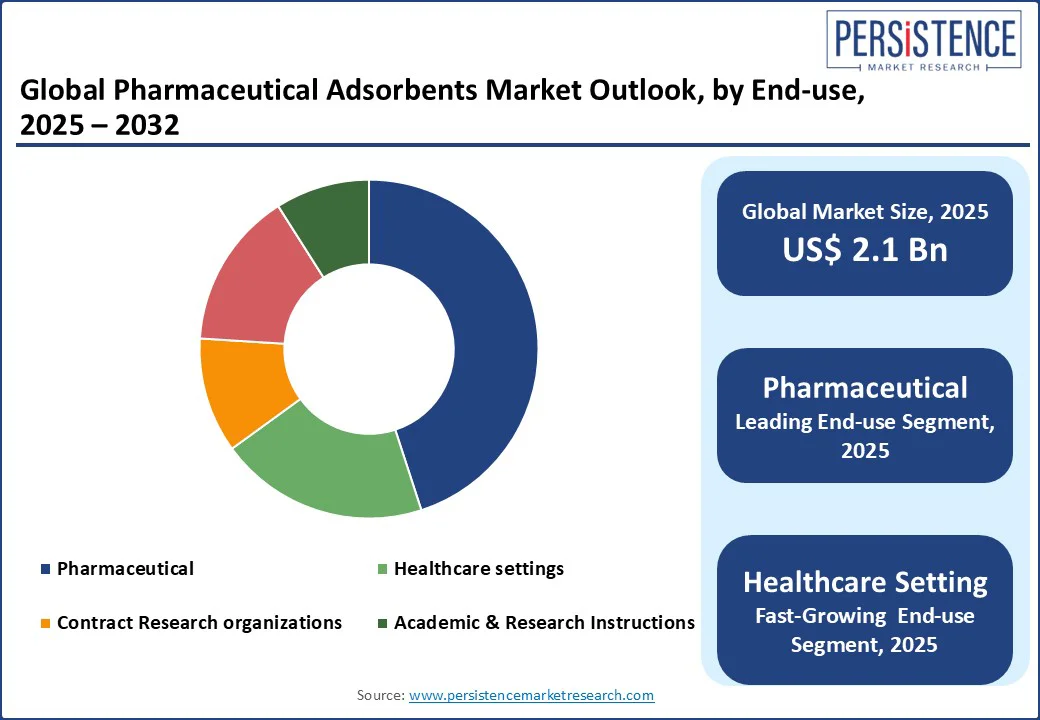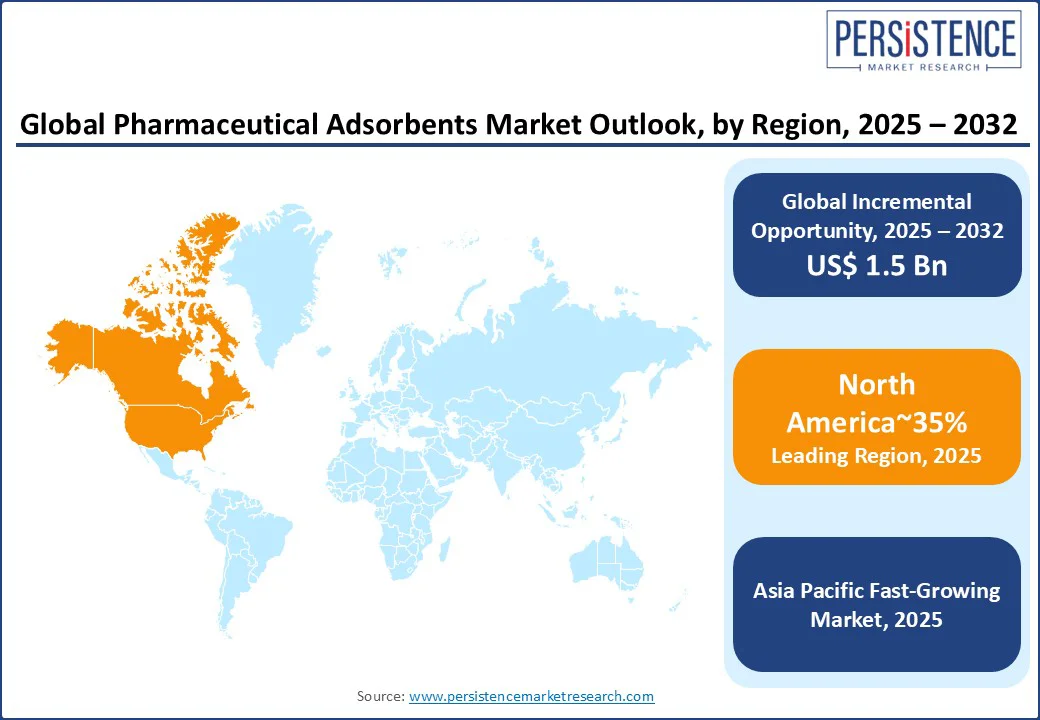ID: PMRREP28135| 172 Pages | 24 Aug 2025 | Format: PDF, Excel, PPT* | Healthcare

The global pharmaceutical adsorbents market is likely to be valued at US$ 2.1 Bn in 2025. It is expected to grow to US$ 3.6 Bn by 2032, expanding at a CAGR of 8.1% during the forecast period from 2025 to 2032.
The pharmaceutical adsorbents industry is expanding, driven by increasing demand for high-purity drugs and advanced purification methods. Growth in pharmaceutical manufacturing, especially biologics, along with stricter regulatory standards, fuels adoption. Innovations in sustainable, eco-friendly adsorbents and improvements in adsorption technology further support market growth, making pharmaceutical adsorbents essential for safe and effective drug production.
Key Industry Highlights

|
Global Market Attribute |
Key Insights |
|
Pharmaceutical Adsorbents Market Size (2019) |
US$1.3 Bn |
|
Pharmaceutical Adsorbents Market Size (2025E) |
US$2.1 Bn |
|
Market Value Forecast (2032F) |
US$3.6 Bn |
|
Projected Growth (CAGR 2025-2032) |
8.1% |
|
Historical Market Growth (CAGR 2019-2024) |
7.6% |
The rapid expansion of the pharmaceutical industry is a significant driver of the pharmaceutical adsorbents market. With increasing global demand for medications due to aging populations, rising chronic disease cases, and advances in healthcare infrastructure, pharmaceutical manufacturers are scaling production.
This surge necessitates efficient purification processes, where pharmaceutical adsorbents play a crucial role in removing impurities, colorants, and contaminants during drug formulation. As a result, the demand for high-quality adsorbents such as activated carbon and synthetic resins has seen notable growth.
For instance, according to the IQVIA Institute, pharmaceutical spending is projected to reach $ 1.9 trillion by 2027. This growth fuels the need for advanced drug formulation and safety measures, directly impacting the adoption of pharmaceutical adsorbents.
With strict regulatory standards from agencies such as the FDA and EMA, manufacturers increasingly rely on adsorbents to meet compliance, ensuring product purity and patient safety-boosting the pharmaceutical adsorbents market worldwide.
High production costs and raw material volatility pose significant challenges to the pharmaceutical adsorbents market. The cost of manufacturing premium adsorbents, such as resin-based variants, rose by 14% in 2025 due to supply chain disruptions and fluctuations in petrochemical feedstocks. This impacts affordability for small and medium-sized enterprises (SMEs), limiting market penetration in cost-sensitive regions.
Competition from alternative purification technologies, such as membrane filtration and centrifugation, restricts growth, with 38% of manufacturers opting for these methods in routine processes due to lower long-term costs. Environmental regulations targeting synthetic materials have increased compliance costs by 12%, affecting the scalability of non-recyclable adsorbents.
The rise of eco-friendly pharmaceutical adsorbents and e-commerce expansion presents significant growth opportunities. The global sustainable materials market is projected to grow rapidly, driving demand for bio-based adsorbents made from renewable sources. A 2025 report notes that 30% of new product launches focus on green adsorbents, boosting controlled release applications by 24%.
Online retail channels for pharmaceutical supplies, growing at 28%, enhance accessibility for silica gel and activated carbon products. Companies are investing US$180 million in R&D for customized adsorbents targeting biotechnology, positioning these as key drivers in emerging markets with 2.8 billion urban consumers by 2030. Innovations in nanotechnology and AI-optimized adsorbents further enhance efficiency, offering opportunities for market differentiation in pharmaceutical purification and drug delivery device systems.
Activated carbon holds a dominant position in the pharmaceutical adsorbents market, accounting for approximately 40% of the total market share. Its widespread use is attributed to its high adsorption capacity, cost-effectiveness, and proven efficiency in purifying active pharmaceutical ingredients (APIs).
Activated carbon is extensively used to eliminate organic impurities, decolorize solutions, and improve drug stability, making it a staple in both generic and branded drug production. As pharmaceutical companies prioritize product quality and regulatory compliance, demand for activated carbon continues to grow steadily.
On the other hand, activated alumina is emerging as the fastest-growing adsorbent type in the pharmaceutical adsorbents market. Its superior performance in adsorbing moisture, acidic contaminants, and polar compounds is gaining attention in advanced drug formulations.
According to recent market analysis, the activated alumina segment is expected to grow at a CAGR of over 7% through 2030. This trend reflects the shift toward more efficient, high-performance adsorbents in modern pharmaceutical processes.
Drug purification, particularly in the production of active pharmaceutical ingredients (APIs), dominates the pharmaceutical adsorbents market, holding an estimated 55% market share as of 2023. Pharmaceutical adsorbents such as activated carbon, synthetic resins, and activated alumina are critical for removing impurities, decolorizing compounds, and ensuring regulatory compliance.
As the demand for high-purity drugs continues to rise globally, especially in chronic disease and oncology sectors, API manufacturers are heavily investing in adsorbent technologies to meet stringent quality standards. This makes drug purification the most lucrative application in the pharmaceutical adsorbents landscape.
The fastest-growing segment within the pharmaceutical adsorbents market is advanced drug formulation, which includes applications such as controlled release systems, stability studies, and adsorption chromatography. These processes use adsorbents to enhance drug shelf life, ensure moisture control, and regulate release profiles in complex formulations.
Driven by innovations in personalized medicine, biologics, and increasing demand for high-performance drug delivery systems, this application is witnessing rapid adoption. As pharmaceutical companies seek enhanced patient outcomes and regulatory approval, the need for advanced adsorbent solutions in formulation is expected to surge through 2030.
The pharmaceutical sector is the leading end-use industry for pharmaceutical adsorbents, accounting for nearly 50% of the global market share in 2023. This dominance is driven by the industry's high reliance on adsorbents for drug formulation, purification, and compliance with stringent quality standards.
Adsorbents are extensively used in the manufacturing of active pharmaceutical ingredients (APIs) and finished dosage forms, ensuring product safety, stability, and regulatory approval. With increasing investments in drug development, especially in oncology and chronic disease segments, pharmaceutical companies continue to be the primary consumers of adsorbent materials worldwide.
Healthcare settings, including hospitals, clinics, and diagnostic labs, are emerging as the fastest-growing end-use segment in the pharmaceutical adsorbents market. The rising adoption of adsorbents in on-site compounding, drug storage, and contamination control is driving this growth.
As healthcare infrastructure expands globally and personalized treatment models gain momentum, the demand for high-quality, stable drug formulations within medical environments is accelerating. This shift is expected to contribute significantly to market expansion through 2030, especially in emerging economies with growing healthcare investments.

North America currently dominates the pharmaceutical adsorbents market, holding an estimated 35% share in 2025. This leadership is driven by a highly advanced pharmaceutical industry, robust R&D activities, and strict regulatory frameworks from bodies such as the FDA.
The region’s high drug consumption, increasing biologics production, and widespread adoption of purification technologies further fuel demand for pharmaceutical adsorbents. Major pharmaceutical manufacturers and raw material suppliers headquartered in the U.S. and Canada also contribute significantly to this strong market position.
Europe maintains a notable share in the pharmaceutical adsorbents market, supported by strong healthcare systems and a growing focus on sustainable pharmaceutical production. Regulatory bodies such as the EMA enforce high standards for drug quality and safety, encouraging the adoption of efficient adsorbent technologies.
Additionally, the region’s pharmaceutical hubs in Germany, Switzerland, and the UK are investing in advanced drug formulation and purification processes, maintaining steady demand for adsorbents across multiple applications.
Asia Pacific is the fastest-growing region in the pharmaceutical adsorbents market, driven by expanding pharmaceutical manufacturing in countries such as China, India, and South Korea. Increasing healthcare expenditure, rising generic drug production, and favorable government policies are propelling growth.
The region’s growing focus on improving drug quality and meeting international regulatory standards is encouraging pharmaceutical companies to adopt high-performance adsorbents. With rapid industrialization and a rising burden of chronic diseases, the Asia Pacific is expected to witness the highest CAGR through 2030.

The global pharmaceutical adsorbents market features moderate fragmentation, driven by ongoing innovation and stringent regulatory standards. Manufacturers prioritize developing high-performance adsorbents designed for drug purification, controlled release, and stability enhancement. Competitive strategies include expanding production capacity, forging regional partnerships, and adopting sustainable manufacturing practices.
Compliance with Good Manufacturing Practices (GMP) and global pharmacopoeia requirements ensures product quality and reliability. Increasing pharmaceutical production in emerging markets, especially the Asia Pacific, intensifies competition, making innovation, certification, and cost efficiency crucial for market growth and differentiation.
The pharmaceutical adsorbents market is projected to reach US$ 2.1 Bn in 2025, driven by pharmaceutical purification and drug formulation demands.
Key drivers include high-purity drug requirements, biotechnology advancements, and stringent regulatory standards.
The pharmaceutical adsorbents market is expected to grow at a CAGR of 8.1% from 2025 to 2032, reaching US$ 3.6 Bn.
Opportunities include eco-friendly pharmaceutical adsorbents, e-commerce expansion, and innovative applications in biotechnology.
Leading players include Arkema S.A., BASF SE, Clariant AG, Honeywell International Inc., and Cabot Corporation.
|
Report Attribute |
Details |
|
Historical Data/Actuals |
2019 - 2024 |
|
Forecast Period |
2025 - 2032 |
|
Market Analysis Units |
Value: US$ Bn, |
|
Geographical Coverage |
|
|
Segmental Coverage |
|
|
Competitive Analysis |
|
|
Report Highlights |
|
|
Customization and Pricing |
Available upon request |
By Adsorbent Type
By Application Type
By End-use
By Region
Delivery Timelines
For more information on this report and its delivery timelines please get in touch with our sales team.
About Author